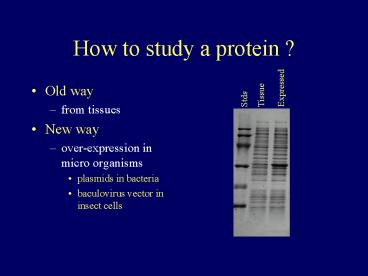How to study a protein - PowerPoint PPT Presentation
1 / 16
Title:
How to study a protein
Description:
ATC GAA GGT CGT GGG ATC CCC AGG AAT TCC CGG GTC GAC TCG AGC GGC CGC ... adenovirus (lytic) papilloma (episomal) retrovirus (integrated) calcium phosphate ... – PowerPoint PPT presentation
Number of Views:20
Avg rating:3.0/5.0
Title: How to study a protein
1
How to study a protein ?
Expressed
Stds Tissue
- Old way
- from tissues
- New way
- over-expression in micro organisms
- plasmids in bacteria
- baculovirus vector in insect cells
2
Expression of Recombinant Proteins
- Expression Vector Features
- gene dosage
- strong promoter
- inducible promoter
- translation signals, etc
- fusion proteins
- protease defective hosts
3
(No Transcript)
4
- increase stability
- affinity purification
- detection/assay
- spectrophotometric
- binding assays
- antibodies
- export signals
Fusion Proteins
5
Preparation of Expression Vector
- subclone insert from current vector to expression
vector - design PCR primers to amplify region of interest
- expressed protein must be
- correct orientation
- in-frame
BamH1 EcoR1 SmaI
SalI XhoI NotI ... ATC GAA GGT CGT GGG
ATC CCC AGG AAT TCC CGG GTC GAC TCG AGC GGC CGC
... ... TAG CTT CCA GCA CCC TAG GGG TCC TTA AGG
GCC CAG CTG AGC TCG CCG GCG ... ... Ile Glu Gly
Arg Gly Ile Pro Arg Asn Ser Arg Val Asp Ser Ser
Gly Arg ... Factor Xa
6
- Possible IB Cure
- isolate by differential centrifugation
- solubilize in urea
- re-nature protein (?)
7
1. Engineered protease site allows removal of
fusion partner
8
2. Addition of a few residues should have minimal
effect on recombinant protein
- His6 Tag
- add 6 consecutive His to either end
- binds metals
- Epitope Tag
- 6-12 amino acids
- mAb for detection or purification
9
Expression
- Strong but controllable promoter
- selectable marker
- multiple cloning site
- translational start site
- Fusion protein
10
(No Transcript)
11
12
Fraction number
35
25
pure protein
13
(No Transcript)
14
Problems with Expression of Eukaryotic Proteins
in Prokaryotes
- stability (protein and gene)
- proper folding and disulfide formation
- post-translational modifications
- asking species specific questions
15
Eukaryotic Expression Systems
- in theory, plasmids can be introduced into any
host - yeast are easy to maintain in lab
- Saccharomyces cerevisiae
- Pichia pastoris
- viruses
- several mammalian
- baculovirus (insect)
vaccinia (lytic) adenovirus (lytic) papilloma
(episomal) retrovirus (integrated)
16
Transfection Methods
- calcium phosphate
- DEAE-dextran
- electroporation
- liposomes
- protoplast fusion
- ballistics (gene gun)
- microinjection































